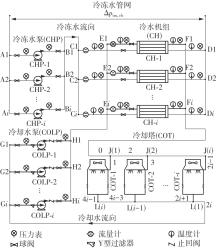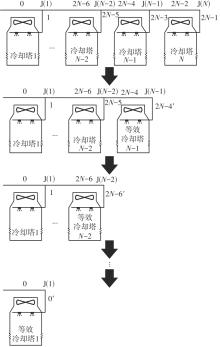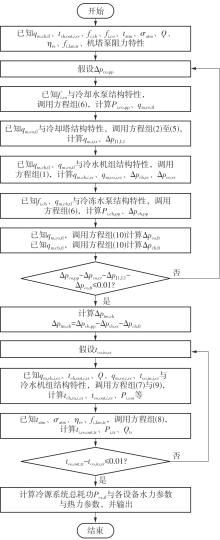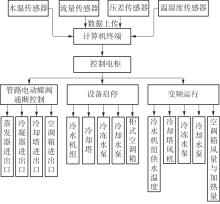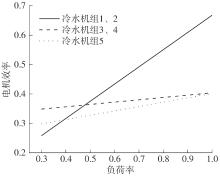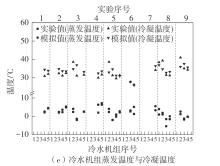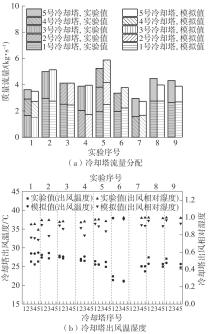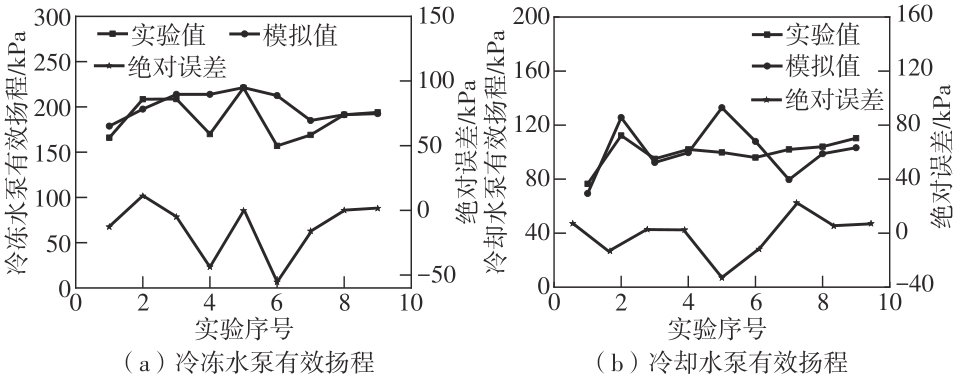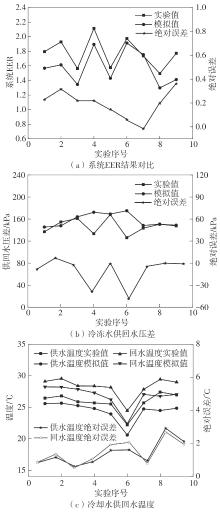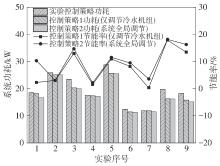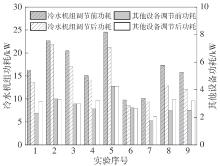Journal of South China University of Technology(Natural Science Edition) ›› 2024, Vol. 52 ›› Issue (5): 139-152.doi: 10.12141/j.issn.1000-565X.230085
• Architecture & Civil Engineering • Previous Articles
Multi-Variable Coupled Physical Model of Water-Cooled Centralized Air-Conditioning Cold Source System
LIU Xuefeng, HUANG Bin, DING Liwei, XU Jinman, BI Mengbo
- School of Electric Power Engineering,South China University of Technology,Guangzhou 510640,Guangdong,China
-
Received:2023-03-06Online:2024-05-25Published:2023-05-31 -
About author:刘雪峰(1976-),男,博士,副教授,主要从事制冷与空调系统优化控制与诊断研究。E-mail: lyxfliu @scut.edu.cn -
Supported by:the National Natural Science Foundation of China(51778234);the Natural Science Foundation of Guangdong Province(2020A1515010762)
CLC Number:
Cite this article
LIU Xuefeng, HUANG Bin, DING Liwei, et al. Multi-Variable Coupled Physical Model of Water-Cooled Centralized Air-Conditioning Cold Source System[J]. Journal of South China University of Technology(Natural Science Edition), 2024, 52(5): 139-152.
share this article
Table 2
Main parameters and their measuring instruments"
| 运行参数 | 仪表型号 | 仪表性能 |
|---|---|---|
| 蒸发器、冷凝器流量 | 涡轮流量计 | 40~280 L/min |
| 蒸发温度、冷凝温度 | 热电偶(冷水机组自带) | -30~100 ℃ |
蒸发器、冷凝器 进出口水温 | 热电偶(冷水机组自带) | -30~100 ℃ |
| 冷却塔支路流量 | 欧西泰OXT-CSB-LLJ-SC 超声波流量计 | 0~32 m/s |
| 冷却塔出风温湿度 | Rotronic HL-NT2-D 手持式温湿度传感器 | -10~60 ℃ 0~100% |
| 冷却塔风量 | Testo 410i叶轮风速仪 | 0.4~30.0 m/s |
| 供回水干管温度 | 美控MIK-PX202一体化温度变送器 | 0~50 ℃ |
| 设备进出口压力 | 上海仪川指针式压力表 上海仪川指针式压力表 | 0~0.4 MPa -0.10~0.06 MPa |
Table 3
Experimental conditions"
| 序号 | 实验时间 | 冷冻水总流量/(kg·s-1) | 冷冻水供回水压差 /kPa | 冷冻水干管供水温度 /℃ | 冷负荷 /kW | 环境 温度 /℃ | 环境相对湿度 |
|---|---|---|---|---|---|---|---|
| 1 | 2022-11-17,11:30 | 1.99 | 136.9 | 8.9 | 29.4 | 29.5 | 0.64 |
| 2 | 2022-11-19,10:50 | 2.54 | 154.6 | 9.7 | 42.0 | 29.6 | 0.65 |
| 3 | 2022-11-19,12:18 | 2.53 | 161.1 | 7.0 | 31.8 | 30.4 | 0.64 |
| 4 | 2022-11-19,16:40 | 2.22 | 133.3 | 12.1 | 33.5 | 28.6 | 0.66 |
| 5 | 2022-11-19,17:52 | 2.65 | 168.0 | 7.1 | 41.4 | 26.8 | 0.75 |
| 6 | 2022-11-25,18:31 | 1.91 | 126.1 | 10.5 | 23.8 | 20.6 | 0.96 |
| 7 | 2022-11-27,17:27 | 1.86 | 143.4 | 9.9 | 21.1 | 24.5 | 0.85 |
| 8 | 2022-11-29,19:10 | 2.29 | 150.5 | 5.6 | 26.2 | 25.5 | 0.85 |
| 9 | 2022-11-29,20:05 | 2.28 | 147.6 | 7.5 | 26.0 | 25.3 | 0.89 |
Table 4
Variation of power consumption of the system under different strategies for experiment 3 working conditions"
| 策略序号 | 冷水机组运行方式 | 冷却塔运行方式 | 冷冻水泵运行方式 | 冷却水泵运行方式 | 系统功耗/kW |
|---|---|---|---|---|---|
| 1 | 2-8.8、3-5.5、5-6.9 | 1-50、2-50 | 1-50、2-50、3-50、4-50 | 1-50、2-50、3-50 | 23.57 |
| 2 | 1-7.0、2-7.0、5-7.0 | 1-50、3-50、5-50 | 1-48.5、2-48.5、5-48.5 | 1-50、2-50、5-50 | 20.27 |
| 3 | 2-8.0、3-6.5、4-6.5 | 3-50、4-50、5-50 | 1-48.9、2-48.9、5-48.9 | 2-50、3-50、4-50 | 22.84 |
| 4 | 4-7.0、5-7.0 | 1-50、3-50 | 1-48.9、2-48.9、5-48.9 | 4-50、5-50 | 21.86 |
| 5 | 1-7.0、2-7.0、3-7.0、4-7.0 | 2-50、3-50、4-50 | 1-48.5、2-48.5、5-48.5 | 1-50、2-50、3-50、4-50 | 20.36 |
| 6 | 1-7.0、2-7.0、3-7.0、4-7.0 | 1-50、3-50 | 1-48.5、2-48.5、5-48.5 | 1-50、3-50 | 21.80 |
Table 5
Comparison of different operation strategies under nine working conditions"
| 序号 | 冷水机组 运行方式 | 冷却塔 运行方式 | 冷冻水泵 运行方式 | 冷却水泵 运行方式 |
|---|---|---|---|---|
| 1 | 4-8.8、5-9.0 | 3-50、4-50、5-50 | 3-50、4-50 | 4-50、5-50 |
| 1-8.9、2-8.9、5-8.9 | 1-50、2-39、3-45 | 1-40、3-49、5-40 | 1-48、2-48、3-42、4-40、5-48 | |
| 2 | 3-9.0、4-9.8、5-9.9 | 1-50、3-50 | 4-50、5-50 | 2-50、3-50、4-50、5-50 |
| 3-9.7、4-9.7、5-9.7 | 1-50、2-50 | 4-50、5-50 | 2-50、3-50、4-50、5-50 | |
| 3 | 2-8.8、3-5.5、5-6.9 | 1-50、2-50 | 1-50、2-50、3-50、4-50 | 1-50、2-50、3-50 |
| 1-7.2、2-7.0、5-6.9 | 1-50、2-45 | 1-48、2-49、5-48 | 3-50、4-50、5-50 | |
| 4 | 4-12.4、5-12.0 | 2-50、3-50 | 2-50、5-50 | 1-50、2-50、3-50 |
| 1-13.2、2-12.8、5-11.2 | 1-50、2-50 | 2-50、5-50 | 2-50、3-50、4-50、5-50 | |
| 5 | 2-9.1、3-5.1、4-6.9、5-7.1 | 1-50、2-50、4-50 | 3-50、4-50、5-50 | 全开-50 |
| 1-7.4、2-7.1、4-6.9、5-7.1 | 1-50、2-50、4-50 | 3-50、4-50、5-50 | 全开-50 | |
| 6 | 3-10.0、4-11.0 | 1-50、4-50 | 1-50、2-50、3-50 | 1-50、2-50、3-50 |
| 2-10.5、5-10.5 | 1-50、2-50 | 1-50、2-50、3-50 | 1-50、2-50、3-50 | |
| 7 | 5-9.9 | 4-50、5-50 | 3-50、4-50 | 1-50、2-50 |
| 5-9.9 | 2-41、4-39 | 2-44、3-47、5-40 | 2-40、4-40、5-50 | |
| 8 | 1-6.6、2-6.9、3-4.5、4-4.6 | 1-50、5-50 | 1-50、2-50、4-50 | 1-50、2-50、3-50 |
| 1-6.0、2-5.7、4-5.3 | 1-48、3-48、4-47 | 2-49、5-49 | 1-46、2-43、3-49、4-41、5-38 | |
| 9 | 2-9.1、3-6.2、4-7.3 | 1-50、5-50 | 1-50、2-50、4-50 | 1-50、2-50、3-50 |
| 1-7.9、5-7.3 | 1-44、2-34、3-46 | 1-43、3-50、5-43 | 1-47、2-43、3-46、4-42、5-38 |
| 1 | 杜祥琬 .如何实现碳达峰和碳中和[J].中国石油石化,2021(1):26. |
| DU Xiangwan .How to achieve carbon peak and carbon neutrality[J].China Petrochem,2021(1):26. | |
| 2 | 索荣 .走出误区,找准碳中和的现实路径——南方科技大学创新创业学院院长刘科谈不一样的减碳观[J].中国石油和化工产业观察,2021(9):8-11. |
| SUO Rong .Out of the misunderstanding,find the realistic path of carbon neutrality-Liu Ketan,dean of the School of Innovation and Entrepreneurship,Southern University of Science and Technology,different views on carbon reduction[J].China Petrochemical Industry Observer,2021(9):8-11. | |
| 3 | BEN-DAVID T, RACKES A, WARING M S .Alternative ventilation strategies in U.S.offices:saving energy while enhancing work performance,reducing absenteeism,and considering outdoor pollutant exposure tradeoffs[J].Building and Environment,2017,116:140-157. |
| 4 | 邵嵘 .冷水机组系统能效比的优化控制及人机界面的设计[D].上海:上海交通大学,2004. |
| 5 | THANGAVELU S R, MYAT A, KHAMBADKONE A .Energy optimization methodology of multi-chiller plant in commercial buildings[J].Energy,2017,123:64-76. |
| 6 | YAN C H, WANG S W, XIAO F,et al .A multi-level energy performance diagnosis method for energy information poor buildings[J].Energy,2015,83(1):189-203. |
| 7 | 刘雪峰,刘金平,陈星龙,等 .同程布置冷水系统管网水力特性计算机分析[J].暖通空调,2012,42(10):121-127. |
| LIU Xuefeng, LIU Jinping, CHEN Xinglong,et al .Computer calculation method of hydraulic characteristics of reversed return chilled water system[J].HV&AC,2012,42(10):121-127. | |
| 8 | YANG J, WU J H, XIAN T,et al .Research on energy-saving optimization of commercial central air-conditioning based on data mining algorithm[J].Energy & Buildings,2022,272:112326/1-15. |
| 9 | JAYAMAHA L .Energy-efficient building systems:green strategies for operation and maintenance[M].New York:McGraw-Hill Digital,2007. |
| 10 | ASHRAE .2021 ASHRAE handbook:fundamentals.SI edition[M].Georgia:ASHRAE,2021. |
| 11 | 任聪 .中央空调系统关键设备故障诊断研究[D].成都:电子科技大学,2019. |
| 12 | WANG K, YANG S, CHEN S .Smart control of air conditioning systems in manufacturing systems facing uncertainty[J].Procedia CIRP,2022,107:770-775. |
| 13 | 凌善旭,梁彩华,张小松 .集中式空调系统调控策略优化与节能研究[J].建筑科学,2017,33(8):35-41. |
| LING Shanxu, LIANG Caihua, ZHANG Xiaosong .Study on control strategy optimization and energy saving of central air conditioning system[J].Building Science,2017,33(8):35-41. | |
| 14 | YAO Y, CHEN J .Global optimization of a central air-conditioning system using decomposition-coordination method[J].Energy & Buildings,2010,42(5):570-583. |
| 15 | TU D X, XIA H W, YIN H J,et al .Optimization of group control strategy and analysis of energy saving in refrigeration plant[J].Energy and Built Environment,2022,3(4):525-535. |
| 16 | TIAN Z C, SI B H, SHI X,et al .An application of Bayesian network approach for selecting energy efficient HVAC systems[J].Journal of Building Engineering,2019,25:100796/1-9. |
| 17 | YUE N H, LI L L, MORANDI A,et al .A metamodel-based multi-objective optimization method to balance thermal comfort and energy efficiency in a campus gymnasium[J].Energy & Buildings,2021,253:111513/1-15. |
| 18 | HUANG Z J, CHEN X F, WANG K W,et al .Air conditioning load forecasting and optimal operation of water systems[J].Sustainability,2022,14:4867/1-12. |
| 19 | 宋一平 .集中空调冷水系统全面优化运行研究[D].哈尔滨:哈尔滨工业大学,2020. |
| 20 | CHEN J Y, SUN Y J .A new multiplexed optimization with enhanced performance for complex air conditioning systems[J].Energy and Buildings,2017,156:85-95. |
| 21 | AFRAM A, JANABI-SHARIFI F .Review of modeling methods for HVAC systems[J].Applied Thermal Engineering,2014,67(1/2):507-519. |
| 22 | 刘雪峰 .中央空调冷源系统变负荷运行控制机理与应用研究[D].广州:华南理工大学,2012. |
| 23 | 刘雪峰,丁笠伟,徐瑾蔓,等 .一种冷却塔的水量分配方法、装置、设备和存储介质:CN114294992B[P].2022-09-20. |
| 24 | 林立昌,刘青荣,阮应君 .基于实测数据并联变频水泵运行优化[J].科学技术与工程,2020,20(30):12546-12551. |
| LIN Li-chang, LIU Qing-rong, RUAN Ying-jun .Operation optimization of variable-speed parallel water pumps based on measured data[J].Science Technology and Engineering,2020,20(30):12546-12551. | |
| 25 | 吴业正,李红旗,张华 .制冷压缩机[M].3版.北京:机械工业出版社,2017. |
| 26 | 杨世铭,陶文铨 .传热学[M].4版.北京:高等教育出版社,2006. |
| 27 | 石文星,田长青,王宝龙 .空气调节用制冷技术[M].5版.北京:中国建筑工业出版社,2016. |
| 28 | 史美中,王中铮 .热交换器原理与设计[M].6版.南京:东南大学出版社,2018. |
| 29 | 黄翔 .空调工程[M].3版.北京:机械工业出版社,2017. |
| 30 | 机械通风冷却塔 第1部分:中小型开式冷却塔: [S]. |
| 31 | 史佑吉 .冷却塔运行与试验[M].北京:水利电力出版社,1990. |
| [1] | WANG Lingzhi, ZHANG Kun, QIAN Fucai. Probability Density Function Shape Control Method for Nonlinear Stochastic Systems Based on Compactly Supported Multi-Variable Polynomials [J]. Journal of South China University of Technology(Natural Science Edition), 2024, 52(7): 39-52. |
| [2] |
YAN Junwei HUANG Qi ZHOU Xuan .
Energy-saving Optimization Operation of Central Air-conditioning System Based on Double-DQN Algorithm
|
| [3] |
Liu Jin-ping Lu Zhi-tao Liu Xue-feng Xing Kong-zu Mai Yue-bang.
An Evaluation Method of Annual Energy Consumption of Chilled Water Pumps Group Based on Suboptimal Solutions
[J]. Journal of South China University of Technology (Natural Science Edition), 2015, 43(7): 106-117.
|
| [4] | Pu Han-jun Xie Xiao-peng Jia Shang-yu Liang Guang-chi Yun Xiang-yong Pan Hai-ning. Physical Modeling and Mechanical Analysis of Non-Rotation Wire Rope Under Straight Tension [J]. Journal of South China University of Technology(Natural Science Edition), 2011, 39(11): 53-58. |
| [5] | Yao Zhi-xiαng Jian Hua li Liu Huan-bin. Determination of Independent Variable Number in Multi -Variable Statistical Analysis [J]. Journal of South China University of Technology (Natural Science Edition), 2007, 35(1): 123-128. |
| [6] | Ding Yun-fei, Ding Jing, Wang Zhuo-yue, et al. Removing of Moisture Load in Cooling Ceiling Air-conditioning System by Rotary Dehumidifier [J]. Journal of South China University of Technology(Natural Science Edition), 2004, 32(3): 10-14. |
| Viewed | ||||||
|
Full text |
|
|||||
|
Abstract |
|
|||||
